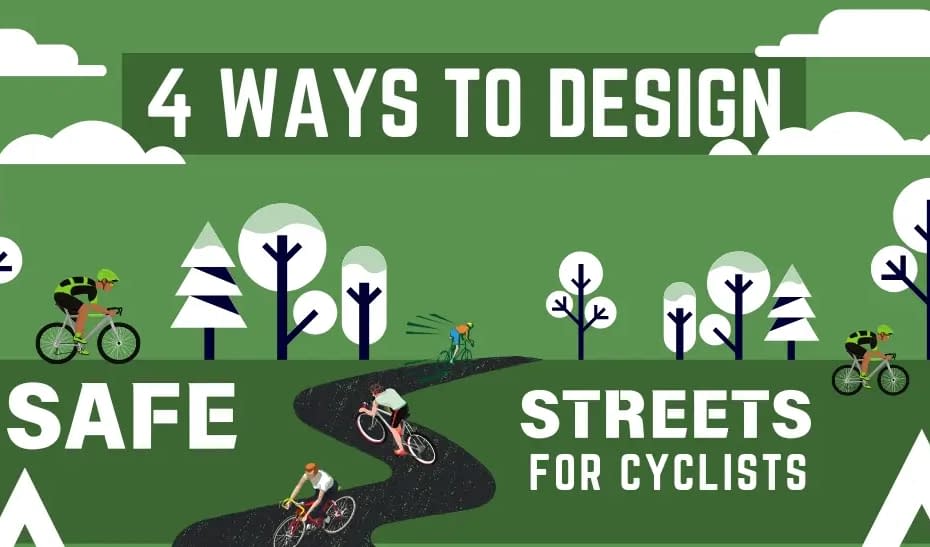As cities worldwide strive for sustainability and improved quality of life, ensuring safe roads for cyclists has become a pressing concern. This article explores four key strategies for designing safer streets for cyclists, encompassing infrastructure, policy, and communication interventions. By implementing these measures, cities can create more harmonious, efficient, and eco-friendly urban environments.
1. Protected Bike Lanes
Protected bike lanes are a fundamental component of cyclist safety. They physically separate cyclists from motor vehicle traffic, creating a safer environment, especially for less experienced riders.
Key Features:
- Physical Barriers: Bollards, planters, or curbs create a clear distinction between bike lanes and vehicle lanes.
- Clear Markings: Signage and pavement markings delineate cycling zones.
- Intersection Treatments: Design elements like bike boxes and advanced stop lines prioritize cyclists at intersections.
- Width Considerations: Ample width allows for safe overtaking and accommodates two-way traffic if necessary.
Benefits:
Protected bike lanes significantly reduce the risk of collisions between cyclists and motorists. They also boost cyclist confidence, encouraging more people to cycle regularly.
Implementation Challenges:
Constructing protected bike lanes can be expensive and may require reallocating street space, potentially leading to community resistance. However, the long-term benefits of increased cyclist safety and higher cycling rates outweigh these initial challenges.
2. Intersection Redesign
Intersections pose the greatest danger to cyclists in urban settings. Redesigning intersections with cyclist safety in mind is crucial to mitigating these risks.
Key Features:
- Bike Boxes: Designated areas at the front of traffic lanes allow cyclists to wait safely at red lights.
- Advanced Stop Lines: Give cyclists a head start at intersections, increasing their visibility to motorists.
- Protected Intersections: Separate cyclists and vehicles throughout the intersection, minimizing conflict points.
- Bicycle-Specific Signals: Traffic signals tailored to cyclist movements enhance predictability and safety.
Benefits:
Intersection redesigns reduce the likelihood of “right-hook” collisions and provide clearer, safer paths for cyclists. They also foster awareness between cyclists and motorists, reducing the potential for accidents.
Implementation Considerations:
Intersection improvements may require adjustments to traffic flow patterns. Successful implementation hinges on educating all road users about the new intersection layouts and associated rules.
3. Traffic Calming Measures
Traffic calming strategies aim to reduce motor vehicle speeds, creating a safer environment for cyclists and pedestrians.
Effective Techniques:
- Speed Humps and Raised Crosswalks: Physical obstacles that encourage slower speeds.
- Narrowed Lanes and Chicanes: Design elements that create a sense of narrowness, prompting drivers to slow down.
- Roundabouts: Traffic circles that naturally reduce speeds and prioritize yielding.
- Reduced Speed Limits: Lowering speed limits in areas with high cycling activity.
Benefits:
Traffic calming measures reduce the speed differential between cyclists and motor vehicles, decreasing the severity of potential accidents. They also create a more pleasant urban environment, encouraging cycling and walking.
Implementation Challenges:
Some motorists may perceive traffic calming measures as inconvenient. Proper design and public education are essential to address concerns and ensure acceptance.
4. Connected Cycling Network
Developing a safe, interconnected cycling network throughout a city enables cyclists to reach their destinations easily and safely.
Key Elements:
- Continuous Bike Lanes and Paths: Uninterrupted routes for cyclists.
- Protected Corridors: Segregated paths, especially through parks or green spaces.
- Bicycle Underpasses and Overpasses: Safe crossings over or under major barriers like highways.
- Wayfinding Signage: Clear signs directing cyclists to their destinations.
Benefits:
A well-connected network encourages more people to cycle for daily commutes. It also distributes cycling traffic more evenly, reducing congestion on specific routes.
Implementation Considerations:
Building a comprehensive network requires time and careful planning, involving collaboration with various city departments and neighboring communities. While it may entail significant upfront costs, the long-term benefits of reduced traffic congestion and improved public health are substantial.
Conclusion
Implementing these four strategies can significantly improve cyclist safety and encourage cycling as a viable transportation mode. While each strategy may present challenges when implemented individually, their combined impact can be transformative.
It’s important to note that creating safe streets for cyclists extends beyond physical changes. It requires policy adjustments, education for all road users, and ongoing communication to ensure stakeholders understand and embrace the new designs.
As cities grapple with issues like congestion, air pollution, and public health, prioritizing cyclist safety becomes even more critical. By making cycling safe, convenient, and enjoyable, cities can create a positive shift towards a more sustainable and livable future for everyone.
FAQ
What is the typical cost of building protected bike lanes?
Costs vary depending on design and location, but they can range from $100,000 to $1 million per mile.
Do bike lanes negatively impact businesses?
Studies have shown that bike lanes generally have no negative impact on businesses and may even boost sales by attracting more foot and bicycle traffic.
